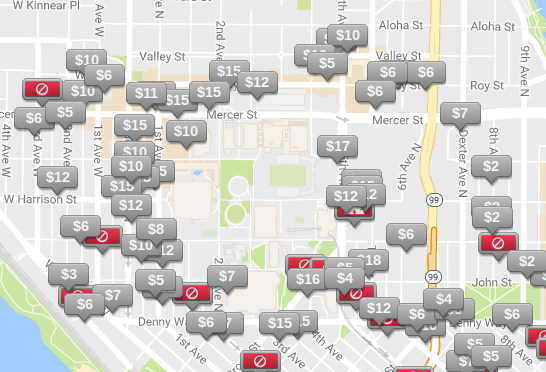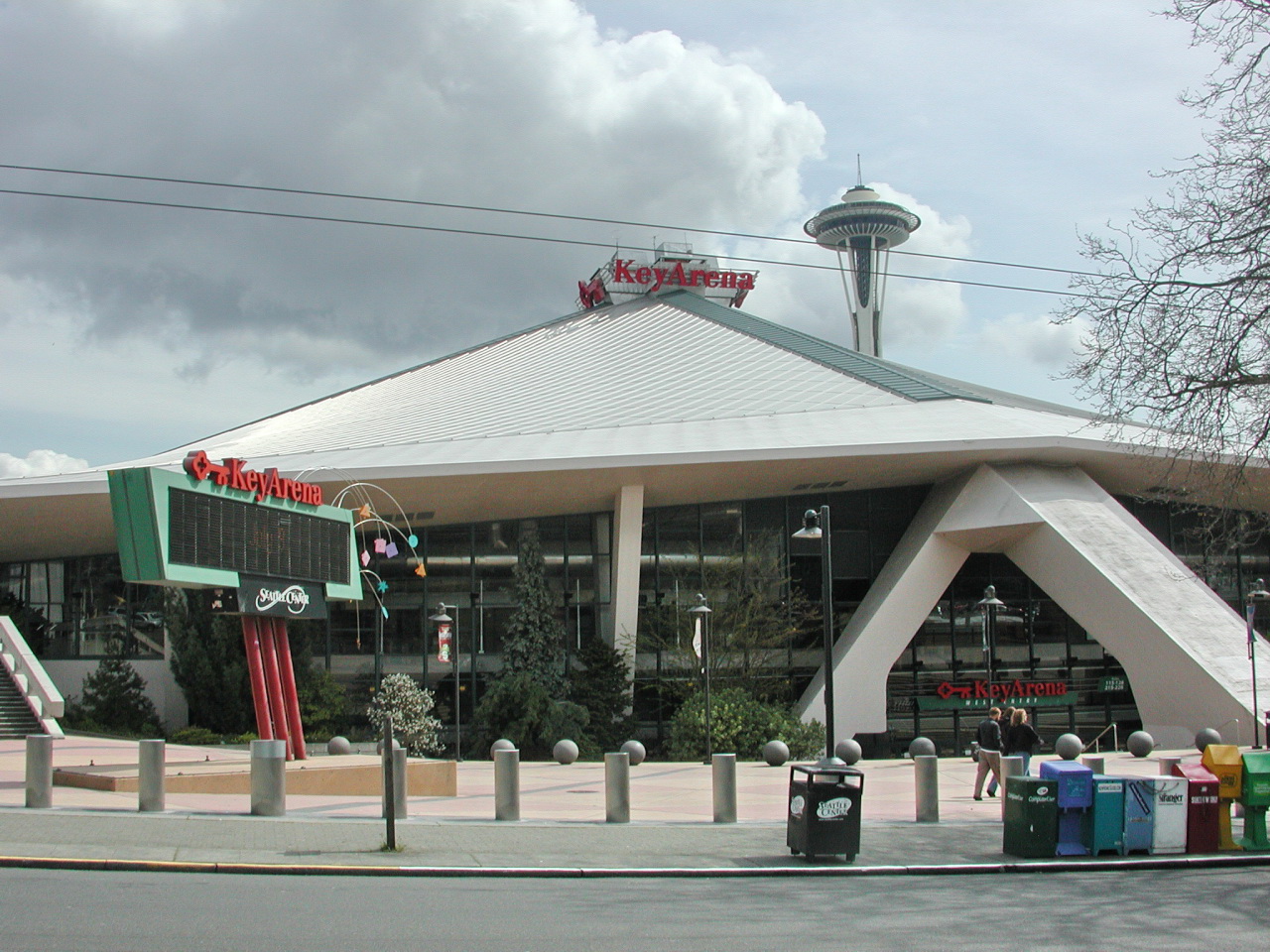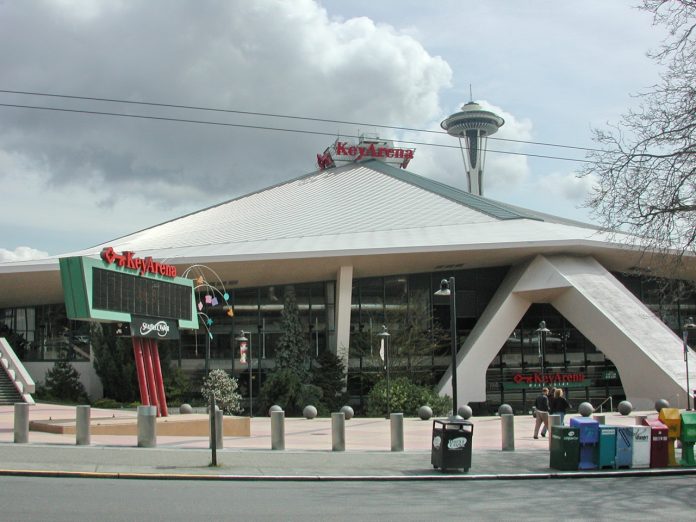The City of Seattle hosted a media tour of KeyArena on Wednesday. The City hoped to get attention for the request for proposals it’s issued to upgrade the Seattle Center arena to support an NBA and/or NHL team. The Seattle Times‘ Matt Calkins took to his column to try to poke holes in the City’s idea. (Note for the rest of the article I will refer to KeyArena as Seattle Center Coliseum since KeyBank has shirked its naming right dues since 2011.)
For those not up-to-date on the arena search, Seattle has been without an NBA franchise since 2008 when owner and Starbucks CEO Howard Schultz sold the SuperSonics to an Oklahoma City-based group. Seattle has never had an NHL franchise but has had plenty of rumors of one. Boosters of either sport say Seattle Center Coliseum is too dated and small and not luxurious enough to support a modern franchise. Three major options have emerged in on-going arena debate.
- SoDo Arena. Hedge fund manager Chris Hansen’s proposal to build a new arena in Sodo, south of Safeco Field.
- Renovate Seattle Center Coliseum. Upgrade City-owned Coliseum to modern NBA/NHL specifications.
- Do nothing. Sports arenas are a dubious public investment so build neither and perhaps reap the most public benefit of all.
Calkins’ framing seems to favor the SoDo site while he rattles off problems with the second option of re-purposing the Seattle Center site:
An AECOM report in June of 2015 suggested KeyArena could be modernized for $285 million. But that report hasn’t done much to quell criticism of the renovation — and those critics’ questions are valid.
For instance: How would the revitalized arena accommodate parking? Garages that surrounded the Key during the Sonics days have since been replaced by housing and other businesses. Just going to a Storm or Seattle University basketball game these days can be a challenge for non-pedestrians, and those events typically draw, at best, less than half of what an NBA or NHL team would.
There also isn’t a light rail stop or freeway exit within a mile of the arena, and as most of us know, Mercer Street traffic is nightmarish whether there is an event at KeyArena or not. So how does one solve the transportation woes?
So, to summarize, Calkins believes parking, traffic, and the Coliseum’s potential historic landmark designation could impede the Seattle Center Coliseum upgrade. The first two points are hard to stomach, particularly for an urbanist. Here’s why: Seattle Center has lots of parking, is well served by transit, and has nearly direct access to SR-99 and, despite the suggestion above, I-5 is just a mile and change away too.
Parking
The obsession with parking isn’t exactly surprising but it is misguided. Calkins is correct that a popular NBA team could be expected to draw twice as many attendees as the Seattle Storm, who have pushed 9,000 average attendance in their more competitive years. However, it’s not clear NBA game day parking demand would be an insurmountable issue given the hundred or so parking garages and lots within a half-mile.

Moreover, we should expect busy events will only induce more people to walk, bike, taxi, or take transit to the arena. In fact, a sensible arena transportation plan would encourage it rather than plowing more parking garages into Seattle neighborhoods. Add to this: the parking problem and traffic problem are inextricably linked. To build more parking is to only exacerbate the traffic problem by drawing more cars to the area.

Traffic
So let’s talk traffic. Mercer Street is certainly a frustrating road at peak times both for motorists and the transit users caught in the crossfire. But will most arena attendees use Mercer Street? The more proximate SR-99 offers an alternative route to the north and to the south (soon in the very expensively built Bertha tunnel). Northwest Seattle has easy access via Elliott and 15th Avenue W. Granted folks headed to the Eastside may still have to deal with Mercer Street, Denny Way, or cut over to I-90, or perhaps use Alaskan Way, which seems to be planned to be built like a highway anyway rather than the complete street that was promised.
Of course, the SoDo arena faces its own traffic congestion concerns, which could be amplified when events are scheduled simultaneously at CenturyLink Field, Safeco Field, and the new SoDo arena. Hansen’s SoDo site has light rail access issues of its own since it’s awkwardly sited three-quarters of a mile away from both Stadium Station and SoDo Station. Plus, SoDo is predominantly industrial meaning fewer people live within walking distance whereas the Seattle Center is adjacent to some of the densest neighborhoods in the state. And minor point: Seattle Center does have Monorail access to Downtown, which may work for some trips.
Additionally, while Calkins laments the Coliseum does not have light rail station access within a mile, that will only be true until Sound Transit completes the Seattle Center station funded in ST3. Granted, Sound Transit doesn’t promise completion until 2035, but if the Ballard to Downtown line is expedited through cooperation with the City of Seattle or phasing construction in two segments, then the Seattle Center station may come on line much sooner. When the Seattle Center station opens, the arena there would boost almost immediate light rail access. Until then, it has solid RapidRide and local bus service.
Landmark Designation
So that leaves us with the historic designation of Seattle Center Coliseum as perhaps the biggest obstacle to renovation. Here’s what outspoken historic preservationist Knute Berger had to say about the Coliseum:
The Coliseum is not currently a designated historic landmark. Word is the city is preparing a nomination that will go to the city’s Landmarks Preservation Board within the next couple of months to settle the question. Artifacts Consulting of Tacoma, a well-respected historic preservation firm, is working on the nomination. They conducted a historic landmark survey of Seattle Center in 2013 and found the Coliseum’s to be landmark eligible. If it is designated a landmark, the city council will approve guidelines for what can and cannot be changed.
It is hard to imagine that the Coliseum won’t meet a number of the required criteria. Its distinctive look (that hyperbolic paraboloid roof suggestive of a Salish rain hat) make it a literal recognizable landmark; it’s a highly significant work by architect Paul Thiry, father of Northwest modernism; it is associated with the historic Seattle World’s Fair; and its original cable roof structure was innovative and, though replaced in the mid-1990s, the form of the roof is intact. No one who attended the World’s Fair in 1962 would fail to recognize the Coliseum exterior today.
The interior, which has been remodeled and reconfigured many times, is very unlikely to qualify for landmark protection, which means that it would be possible to build something entirely new under that roof that is consistent with the landmark status and in keeping with the building’s original purpose. Can it be made to work to current NBA and NHL standards? Consultants for the city and some of the potential RFP bidders say they are sure it can be.
Berger’s assessment could be mistaken and even the exterior of the Coliseum may fail to qualify for landmark status, which would allow a wholesale renovation. But if the exterior does qualify as a landmark, then a renovation of the interior may be sufficient to satisfy the demands of modern major sports franchises. Whatever ends up happening, let’s not be ruled by weak claims about parking and traffic.
Doug Trumm is publisher of The Urbanist. An Urbanist writer since 2015, he dreams of pedestrian streets, bus lanes, and a mass-timber building spree to end our housing crisis. He graduated from the Evans School of Public Policy and Governance at the University of Washington in 2019. He lives in Seattle's Fremont neighborhood and loves to explore the city by foot and by bike.


